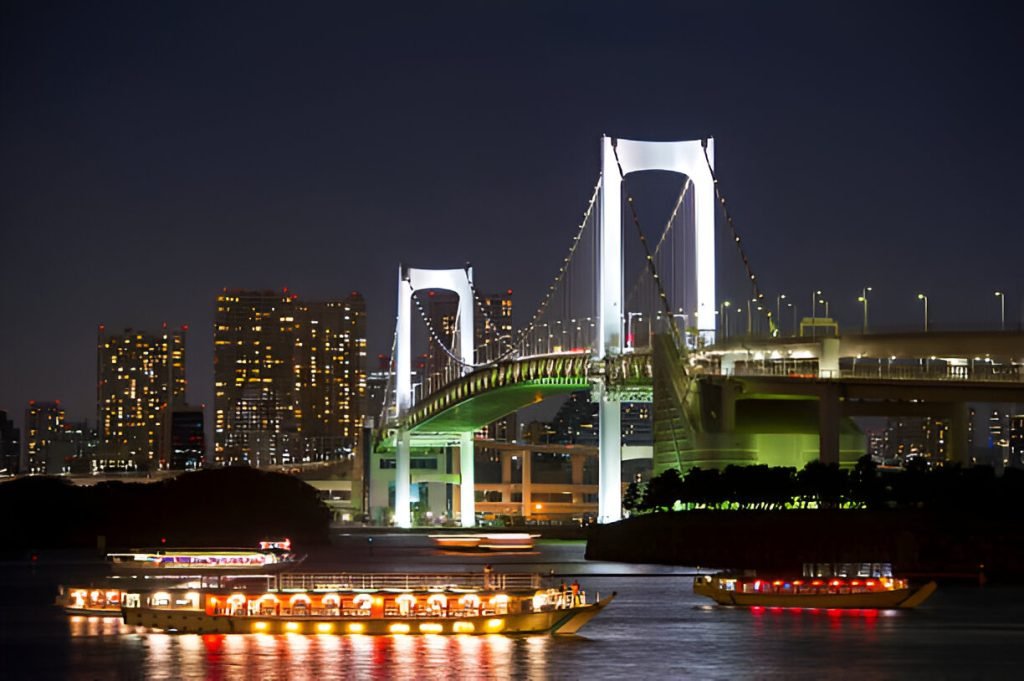
Unveiling Tokyo’s Hidden Culinary Gems: A Local’s Guide to Savoring the City’s Authentic Flavors

Are you ready to embark on a gastronomic adventure through the vibrant streets of Tokyo? Look no further! This insider’s guide will take you on a journey through the city’s lesser-known food spots, revealing the secrets that only locals know. From hole-in-the-wall ramen joints to upscale sushi bars, we’ll explore the diverse and delicious world of Tokyo’s culinary scene.
Introduction: Tokyo’s Culinary Landscape
Tokyo, a city where tradition meets innovation, is a food lover’s paradise. With over 160,000 restaurants, ranging from humble street food stalls to world-renowned fine dining establishments, the sheer variety can be overwhelming. But fear not! This guide will help you navigate the culinary wonderland that is Tokyo, ensuring you experience the best flavors the city has to offer.
As a local food enthusiast and long-time Tokyo resident, I’ve spent years exploring the city’s gastronomic offerings. I’ve slurped ramen at midnight, savored sushi at dawn, and everything in between. Now, I’m excited to share my insider knowledge with you, helping you discover the hidden treasures that make Tokyo’s food scene truly special.
Navigating Tokyo’s Food Districts
Tokyo is divided into several distinct neighborhoods, each with its own unique culinary personality. Let’s explore some of the most notable food districts:
- Tsukiji Outer Market: While the famous inner market has moved to Toyosu, the outer market remains a bustling hub of fresh seafood and traditional Japanese cuisine. Don’t miss the opportunity to try some of the freshest sushi for breakfast!
- Shinjuku: Known for its vibrant nightlife, Shinjuku is also home to some of the best yakitori (grilled chicken skewers) joints in the city. The narrow alleys of Omoide Yokocho, also known as “Piss Alley” (don’t let the name deter you!), are lined with tiny eateries serving up delicious grilled meats and ice-cold beer.
- Shibuya: This trendy district is perfect for those looking to try the latest food crazes. From rainbow cheese toast to animal-shaped cream puffs, Shibuya is where you’ll find Instagram-worthy treats.
- Asakusa: For a taste of old Tokyo, head to Asakusa. This historic district is famous for its traditional sweets and snacks, including ningyoyaki (small cakes filled with red bean paste) and age-manju (deep-fried buns).
- Ginza: If you’re looking for high-end dining experiences, Ginza is the place to be. Home to numerous Michelin-starred restaurants, this upscale district offers some of the finest cuisine in Tokyo.
Pro tip: To truly experience Tokyo’s food scene like a local, venture beyond these popular areas. Some of the best meals I’ve had were in lesser-known neighborhoods like Koenji, Shimokitazawa, and Nakameguro.
Must-Try Local Delicacies
While sushi and ramen might be the first things that come to mind when thinking of Japanese cuisine, Tokyo offers so much more. Here are some local delicacies you absolutely must try:
- Monjayaki: Often overshadowed by its more famous cousin, okonomiyaki, monjayaki is a Tokyo specialty. This savory pancake-like dish is cooked on a hot griddle right at your table. Head to Tsukishima’s “Monja Street” for the best monjayaki experience.
- Chanko Nabe: This hearty hot pot dish is traditionally eaten by sumo wrestlers. For an authentic experience, visit one of the chanko nabe restaurants run by former sumo wrestlers in the Ryogoku area.
- Tsukemen: While ramen gets all the glory, tsukemen (dipping noodles) is a local favorite. Try it at Rokurinsha in Tokyo Station’s “Ramen Street” for a truly memorable meal.
- Wagashi: These traditional Japanese sweets are not only delicious but also visually stunning. Visit Minamoto Kitchoan in Ginza for some of the most beautiful and delectable wagashi in the city.
- Tonkatsu: This crispy breaded pork cutlet is a comfort food staple. For the best tonkatsu experience, head to Maisen in Aoyama, where they serve premium Kurobuta pork.
Remember, these are just a few examples of the many delicious dishes Tokyo has to offer. Don’t be afraid to try something new – you might discover your new favorite food!
Hidden Gems: Off-the-Beaten-Path Eateries
Now, let’s dive into some of Tokyo’s best-kept culinary secrets. These hidden gems might not be in your guidebook, but they’re beloved by locals for their exceptional food and unique atmosphere:
- Savoy: Tucked away in a residential area of Minami-Azabu, this tiny pizzeria serves some of the best Neapolitan-style pizza in Tokyo. With only 10 seats and no reservations accepted, be prepared to wait – but trust me, it’s worth it.Check out reviews of Savoy on Tabelog
- Tempura Fukamachi: Hidden behind an unassuming facade in Kyobashi, this small tempura restaurant offers an unforgettable dining experience. The chef’s attention to detail and the quality of ingredients make this place a must-visit for tempura lovers.Read about Tempura Fukamachi on Tokyo Food File
- Yanaka Beer Hall: Located in the charming old-Tokyo neighborhood of Yanaka, this renovated bathhouse serves craft beer and delicious Japanese-inspired pub food. It’s the perfect spot to relax after exploring the nearby Yanaka Cemetery.Discover more about Yanaka Beer Hall on Time Out Tokyo
- Ace Burger Cafe: If you’re craving a taste of home with a Japanese twist, head to this hidden burger joint in Nakameguro. Their wasabi cheese burger is a local favorite.See what people are saying about Ace Burger Cafe on TripAdvisor
- Tofuya Ukai: Set in a beautiful traditional garden near Tokyo Tower, this tofu restaurant offers a serene dining experience away from the hustle and bustle of the city. Even if you’re not a tofu fan, the exquisite presentation and peaceful atmosphere make this place worth a visit.Learn more about Tofuya Ukai on their official website
Remember, part of the fun of exploring Tokyo’s food scene is discovering your own hidden gems. Don’t be afraid to wander down small alleys or try that tiny restaurant with a line out the door – you might just stumble upon your own secret spot!
Seasonal Specialties: Eating with the Calendar
One of the joys of dining in Tokyo is experiencing the changing flavors of the seasons. Japanese cuisine places a strong emphasis on seasonal ingredients, and many restaurants change their menus to reflect what’s fresh and available. Here’s a quick guide to some seasonal specialties:
- Spring: Look for sakura (cherry blossom) flavored treats, fresh bamboo shoots, and tender young greens.
- Summer: Cool down with cold soba noodles, unagi (grilled eel), and kakigori (shaved ice desserts).
- Autumn: Savor matsutake mushrooms, chestnuts, and seasonal fish like sanma (Pacific saury).
- Winter: Warm up with hearty hot pot dishes, oysters, and winter vegetables like daikon radish.
For a truly special seasonal dining experience, consider visiting one of Tokyo’s kaiseki restaurants. Kaiseki is a traditional multi-course meal that showcases seasonal ingredients prepared in various ways. While it can be pricey, it’s an unparalleled way to experience Japanese culinary artistry.
Learn more about kaiseki cuisine on Japan Guide
Etiquette and Customs: Dining Like a Local
To fully immerse yourself in Tokyo’s food culture, it’s important to understand some basic dining etiquette. Here are some tips to help you dine like a local:
- Chopstick etiquette: Never stick your chopsticks upright in your rice (this resembles a funeral ritual) or pass food directly from your chopsticks to someone else’s.
- Slurping is okay: When eating ramen or soba, slurping is not only acceptable but often encouraged as a sign of enjoyment.
- **Saying “Itadakimasu” and “Gochisousama”: It’s polite to say “Itadakimasu” (literally “I humbly receive”) before eating and “Gochisousama deshita” (thank you for the meal) after finishing.
- Tipping: Tipping is not customary in Japan and can sometimes be seen as rude. Simply pay the amount on your bill.
- Pouring drinks: If dining with others, it’s polite to pour drinks for them rather than for yourself. They will typically return the favor.
Remember, these customs are appreciated but not strictly expected from tourists. Most locals will be understanding if you’re not familiar with all the rules.
Budget-Friendly Options: Delicious Eats on a Shoestring
Contrary to popular belief, dining in Tokyo doesn’t have to break the bank. Here are some wallet-friendly options that don’t compromise on taste:
- Conveyor belt sushi: Chains like Sushiro and Kura Sushi offer plates starting from just 100 yen.
- Standing soba shops: These quick-service noodle shops, often found near train stations, offer hearty bowls of soba or udon at very reasonable prices.
- Yoshinoya, Matsuya, and Sukiya: These gyudon (beef bowl) chains are ubiquitous in Tokyo and offer filling meals for under 500 yen.
- Depachika: The basement food halls of department stores offer a wide variety of ready-to-eat meals and snacks. Visit towards closing time for discounted items.
- Convenience stores: Don’t underestimate the quality of convenience store food in Japan. You can get surprisingly good meals for very little money.
Pro tip: Many restaurants offer lunch specials that are significantly cheaper than their dinner menus. This is a great way to experience high-quality cuisine without the high-end price tag.
High-End Experiences: Michelin-Starred Marvels
For those looking to splurge on an unforgettable culinary experience, Tokyo boasts more Michelin-starred restaurants than any other city in the world. Here are a few standout options:
- Sukiyabashi Jiro: Made famous by the documentary “Jiro Dreams of Sushi,” this 3-Michelin-starred sushi restaurant is helmed by sushi master Jiro Ono.
- Narisawa: Featuring innovative “satoyama cuisine” that emphasizes sustainability and connection to nature, Narisawa offers a unique fine dining experience.
- Den: Chef Zaiyu Hasegawa’s playful take on kaiseki cuisine has earned his restaurant two Michelin stars and a spot on the World’s 50 Best Restaurants list.
- Ginza Kojyu: For a more traditional high-end experience, this 3-Michelin-starred kaiseki restaurant showcases the very best of Japanese cuisine.
- L’Effervescence: Blending French techniques with Japanese ingredients, Chef Shinobu Namae’s innovative cuisine has earned the restaurant two Michelin stars.
Remember to book well in advance for these restaurants, as reservations can be difficult to secure.
Explore more of Tokyo’s Michelin-starred restaurants on the official Michelin Guide website
Vegetarian and Vegan Options in Tokyo
While traditional Japanese cuisine often includes fish or meat, Tokyo has seen a growing number of vegetarian and vegan-friendly establishments in recent years. Here are some top picks:
- T’s TanTan: Located in Tokyo Station, this vegan ramen shop is perfect for a quick, satisfying meal.
- Ain Soph Ripple: Known for their vegan burgers and pancakes, this casual restaurant in Shinjuku is a favorite among locals and tourists alike.
- Saido: This upscale restaurant in Jiyugaoka serves beautiful vegan interpretations of traditional Japanese dishes.
- 8ablish: Offering a mix of Japanese and Western-inspired vegan dishes, this restaurant in Aoyama is great for a special night out.
- Nagi Shokudo: This cozy cafe in Shibuya serves a variety of vegan Japanese and international dishes at very reasonable prices.
Pro tip: When dining at non-vegetarian restaurants, be aware that dashi (fish stock) is commonly used in many dishes, even those that appear vegetarian. Always ask if you’re unsure.
Find more vegetarian and vegan options on Happy Cow
Food Tours and Cooking Classes
To deepen your understanding of Tokyo’s food culture, consider joining a food tour or taking a cooking class. These experiences offer valuable insights and hands-on learning opportunities:
- Tokyo FooDrink Tour: Offers small-group walking tours through various Tokyo neighborhoods, focusing on local specialties and hidden gems.Check out Tokyo FooDrink Tour’s offerings
- Tsukiji Cooking: Learn to make sushi and other Japanese dishes using fresh ingredients from the famous Tsukiji Outer Market.Book a class with Tsukiji Cooking
- Arigato Japan Food Tours: Provides a variety of food tours across Tokyo, including sake tasting and street food tours.Explore Arigato Japan’s Tokyo tours
- Tokyo Ramen Tours: For ramen enthusiasts, this specialized tour takes you to some of the best ramen shops in the city.Join a Tokyo Ramen Tour
- airKitchen: This platform connects travelers with local hosts for in-home cooking classes, offering a more intimate cultural exchange.Find a cooking class on airKitchen
These tours and classes not only provide delicious experiences but also offer valuable cultural insights that will enhance your overall Tokyo food adventure.
Comparison of Tokyo’s Top Food Districts
To help you decide where to focus your culinary explorations, here’s a comparison of some of Tokyo’s top food districts:
| District | Known For | Price Range | Atmosphere | Best Time to Visit |
|---|---|---|---|---|
| Tsukiji | Fresh seafood, sushi | ¥¥-¥¥¥¥ | Bustling, traditional | Early morning |
| Shinjuku | Yakitori, izakayas | ¥-¥¥¥ | Energetic, diverse | Evening |
| Shibuya | Trendy cafes, international cuisine | ¥¥-¥¥¥ | Youthful, vibrant | Afternoon to evening |
| Asakusa | Traditional snacks, tempura | ¥-¥¥ | Historic, laid-back | Midday |
| Ginza | High-end dining, department store food halls | ¥¥¥-¥¥¥¥ | Sophisticated, upscale | Lunch or dinner |
| Roppongi | International cuisine, nightlife | ¥¥-¥¥¥¥ | Cosmopolitan, lively | Evening |
| Koenji | Casual eateries, retro vibes | ¥-¥¥ | Bohemian, relaxed | Afternoon to evening |
| Shimokitazawa | Quirky cafes, vintage shops | ¥-¥¥ | Hipster, artsy | Afternoon |
| Nakameguro | Trendy restaurants, coffee shops | ¥¥-¥¥¥ | Chic, laid-back | Afternoon to evening |
This table should give you a quick overview of what to expect in each district. Remember, these are general characteristics, and you can find a wide range of options in each area.
FAQ: Your Tokyo Food Questions Answered
To wrap up our culinary journey through Tokyo, let’s address some frequently asked questions:
1. Is it safe to eat street food in Tokyo?
Absolutely! Tokyo is known for its high food safety standards, even when it comes to street food. However, true “street food” in the sense of food carts on the street is less common in Tokyo compared to other Asian cities. Most “street food” is sold from small shops or stalls in markets or festivals. Always look for busy stalls with high turnover for the freshest food.
2. How can I dine at high-end restaurants on a budget?
Many high-end restaurants offer lunch sets that are significantly cheaper than their dinner menus but still provide a similar experience. Also, consider going to newly opened restaurants – they often have promotional prices during their first few months of operation.
3. Do I need to make reservations at restaurants in Tokyo?
For popular or high-end restaurants, it’s definitely recommended to make reservations, especially for dinner. Some exclusive restaurants may require reservations months in advance. For casual dining, reservations are often not necessary, but be prepared to wait during peak hours.
4. How can I navigate Tokyo’s restaurants if I don’t speak Japanese?
While it can be challenging, don’t let the language barrier deter you! Many restaurants, especially in tourist areas, have English menus or picture menus. For those that don’t, you can use translation apps or carry a small phrasebook. Often, pointing and gesturing can go a long way. Don’t be afraid to ask for help – many Japanese people are willing to assist even if their English is limited.
5. What should I do if I have dietary restrictions or allergies?
If you have dietary restrictions or allergies, it’s best to carry a card in Japanese explaining your needs. Many restaurants are becoming more accommodating to dietary restrictions, but it’s always best to communicate clearly. For vegetarians and vegans, seek out specialized restaurants or check menus in advance when possible.
Find allergy translation cards on Just Hungry
Remember, exploring Tokyo’s food scene is as much about the journey as it is about the destination. Don’t be afraid to try new things, venture into unfamiliar neighborhoods, and engage with locals. Some of the best culinary experiences come from unexpected discoveries and spontaneous decisions.
Whether you’re slurping ramen in a tiny shop, savoring sushi at a world-renowned restaurant, or snacking on takoyaki at a festival, Tokyo offers a wealth of flavors and experiences to delight every palate. So grab your chopsticks and embark on your own Tokyo food adventure!
If you have more questions or need personalized recommendations, don’t hesitate to ask locals, hotel staff, or join online forums dedicated to Tokyo travel and food. Websites like Tabelog (Japan’s version of Yelp) can also be invaluable resources for finding great places to eat.
Enjoy your culinary journey through Tokyo, and itadakimasu!







